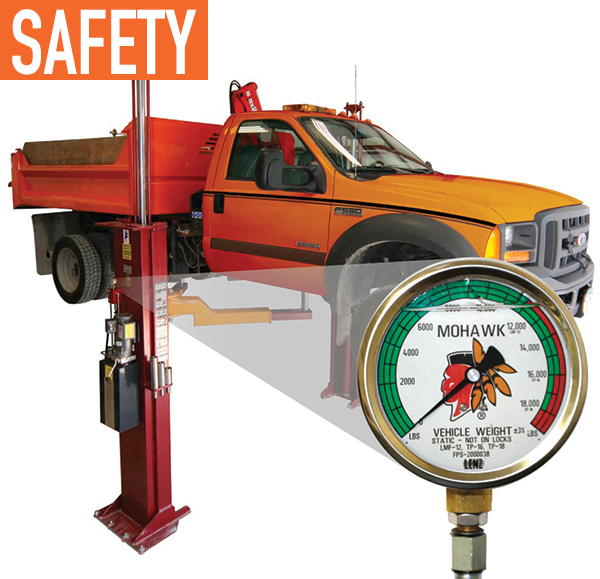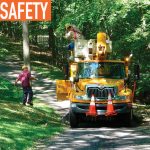As a fleet manager, nothing is more important than everyone in your shop going home safely at the end of each shift. Increasing your technician’s shop safety can happen in many areas, but for this story we’re going to focus on your responsibilities relative to the vehicle lifts in the shop, the techs that use them every day, and the lifts your shop relies on daily to get vehicles repaired and out the door safely.
Much like pieces of heavy machinery, the vehicle lifts in your shop should be inspected. And, like heavy machinery operators, your lift techs should be properly qualified to work lifts.
UNCOMMON KNOWLEDGE
Surprising to many fleet directors is that all technicians using garage lifts need to be qualified on safely using vehicle lifts on an annual basis. A training video is available from the Automotive Lift Institute (ATI) at www.autolift.org, as are online annual certifications. A maintenance log for each of the vehicle service lifts in your shop is also a requirement—as are annual vehicle lift inspections by a trained lift inspector.
One common sense issue not always identified when considering the lift type you’re using is whether an 11,000-lb F-350 can overload a 12,000-lb capacity lift. The answer is yes. Look at the safety decal in Figure 1 and understand that no two-post lift is made to lift more than ¼ of the rated capacity on each swing arm. If the decal in Figure 1 looks like your F-350 and the rear end of your loaded vehicle weighs in at 7,000 or 8,000 lbs, you are overloading your lift. Were an OSHA reportable “incident” ever to happen with the lift, the OSHA representative asks three basic questions:
- What did you know?
- When did you know it?
- What did you do about it?
In other words, make sure the heavy rear end of your F-350 isn’t overloading the lift’s swing arms. This precaution should also be taken when considering the heavy ends on drive on, parallelogram, and mobile column lifts.
LOCK THEN LIFT
Using a vehicle lift without using the mechanical locks is like using a jack without a jack stand. The vehicle should always be lowered onto the lift’s mechanical locks. While you instruct your technicians to use the locks, how can you be sure they really are? The answer is with a visual reminder. Several lift manufacturers have a weight gauge, which will read “0” when the lift is on the locks.
This weight gauge can also act as a diagnostic tool for your techs. If your shop receives a driver complaint from the sheriff that the Crown Victoria isn’t riding right or is getting poor mileage, when the weight gauge shows this Crown Vic weighing in at 6,000 lbs (instead of 3,200 lbs), you might ask the sheriff to remove the lead bars from the trunk to increase mileage and drivability.
While some manufacturers offer a pressure gauge, other brands offer a green light to shine on the ceiling to show the shop manager the locks are engaged.

Above: Figure 1
Featured Image: Several lift manufacturers have a weight gauge, which will read “0” when the lift is on the locks.
BEST PRACTICES
All lifts come with several ALI required booklets, such as Lifting it Right, safety warning decals, a safety tips card, and a current model year vehicle lifting point guide (LPG). Lifting it Right, hosted by Richard and Kyle Petty, can now be taken online at www.autolift.org. If your LPG is outdated, then obviously it does not contain the lifting points of the newer vehicles in your shop. New LPGs are available from the ALI.
There is one—and only one—national safety standard for garage lifts: that being ALI certified. Part of that standard mandates that any accessory used with the lift (i.e. truck frame adaptors, rolling wheel free jacks, and high reach jack stands for mobile lifts) be certified, as placement of a non-certified option on a certified lift will void the lift’s safety certification.
ALL IN ALL
A lift can be one of the most productive pieces of equipment in your garage, enabling you to get vehicles back on the road faster. Yet, a lift might also represent a danger if it doesn’t meet safety standards, hasn’t been inspected, or if the techs using the lift haven’t been properly trained. Safe lifting!
ABOUT THE AUTHOR:
Steve Perlstein has been with Mohawk Lifts for 35 years and is a member of the Automotive Lift Institute.
_______________________________________________________________________
MODERN WORKTRUCK SOLUTIONS: MARCH 2016 ISSUE
Did you enjoy this article?
Subscribe to the FREE Digital Edition of Modern WorkTruck Solutions magazine.
![]()




